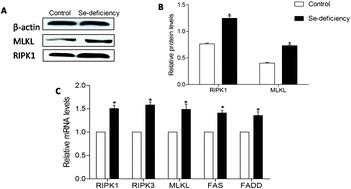当前位置:
X-MOL 学术
›
Metallomics
›
论文详情
Our official English website, www.x-mol.net, welcomes your feedback! (Note: you will need to create a separate account there.)
The role of necroptosis and apoptosis through the oxidative stress pathway in the liver of selenium-deficient swine.
Metallomics ( IF 3.4 ) Pub Date : 2020-03-16 , DOI: 10.1039/c9mt00295b Yuan Zhang 1 , Dahai Yu , Jiuli Zhang , Jun Bao , Chaohua Tang , Ziwei Zhang
Metallomics ( IF 3.4 ) Pub Date : 2020-03-16 , DOI: 10.1039/c9mt00295b Yuan Zhang 1 , Dahai Yu , Jiuli Zhang , Jun Bao , Chaohua Tang , Ziwei Zhang
Affiliation

|
Necroptosis is regarded as a new paradigm of cell death that plays a key role in the liver damage observed with selenium (Se) deficiency. Se deficiency has a significant impact on the livestock and poultry industries. Previous studies have confirmed that Se deficiency causes serious injury to the swine liver; however, it is unclear whether this liver damage is the result of necroptosis and apoptosis. To understand the damage induced by Se deficiency, swine were divided into a control group and Se-deficient group. The results showed that in the liver of swine, Se deficiency initiated apoptosis by increasing the expression of cysteinyl aspartate specific proteinase 3 (caspase-3), cysteinyl aspartate specific proteinase 9 (caspase-9) and BCL-2 antagonist/killer (BAK) at both the mRNA and protein levels and by decreasing the B cell lymphoma/leukemia 2 (BCL-2) levels compared with the levels in the control group. Meanwhile, compared with the control group, necroptosis was confirmed in the liver of Se-deficient swine through increased the expression of mixed lineage kinase domain like pseudokinase (MLKL) and receptor interacting serine/threonine kinase 1 (RIPK1) at both the mRNA and protein levels. In addition, the activities of catalase (CAT), nitric oxide (NO), and total antioxidative capacity (T-AOC) were clearly increased (P < 0.05), and the activities of OH- and total nitric oxide synthase (TNOS) were obviously decreased (P < 0.05), whereas in the Se-deficient group, the hydrogen peroxide (H2O2) and malondialdehyde (MDA) levels were obviously increased (P < 0.05) compared with those in the control group. Moreover, the number of apoptotic cells was increased significantly in the Se-deficient group, and the liver tissues showed obvious necroptosis damage. These results show that Se deficiency induces apoptosis and necroptosis through the oxidative stress pathway in the swine liver.
中文翻译:

缺硒猪肝脏中氧化应激途径引起的坏死病和凋亡的作用。
坏死病被认为是细胞死亡的新范例,在硒缺乏症引起的肝损伤中起关键作用。硒缺乏对畜禽业产生重大影响。先前的研究已经证实,硒缺乏会对猪肝造成严重伤害。然而,目前尚不清楚这种肝损害是否是坏死病和细胞凋亡的结果。为了了解硒缺乏引起的损害,将猪分为对照组和硒缺乏组。结果显示,在猪肝脏中,硒缺乏症通过增加半胱氨酸天冬氨酸特异性蛋白酶3(caspase-3)的表达来引发细胞凋亡,半胱氨酸天冬氨酸特异性蛋白酶9(caspase-9)和BCL-2拮抗剂/杀手(BAK)的mRNA和蛋白水平均降低,且与对照组相比,降低了B细胞淋巴瘤/白血病2(BCL-2)的水平组。同时,与对照组相比,硒缺乏症猪肝脏中的坏死病通过mRNA和蛋白的混合谱系激酶结构域如假激酶(MLKL)和受体相互作用的丝氨酸/苏氨酸激酶1(RIPK1)的表达增加而得以证实水平。此外,过氧化氢酶(CAT),一氧化氮(NO)和总抗氧化能力(T-AOC)的活性明显增加(P <0.05),OH-和总一氧化氮合酶(TNOS)的活性明显增加(P <0.05)。明显降低(P <0.05),而在硒缺乏组,与对照组相比,过氧化氢(H2O2)和丙二醛(MDA)水平明显升高(P <0.05)。此外,缺硒组凋亡细胞数量明显增加,肝组织坏死明显。这些结果表明,硒缺乏通过猪肝脏中的氧化应激途径诱导细胞凋亡和坏死性坏死。
更新日期:2020-03-09
中文翻译:

缺硒猪肝脏中氧化应激途径引起的坏死病和凋亡的作用。
坏死病被认为是细胞死亡的新范例,在硒缺乏症引起的肝损伤中起关键作用。硒缺乏对畜禽业产生重大影响。先前的研究已经证实,硒缺乏会对猪肝造成严重伤害。然而,目前尚不清楚这种肝损害是否是坏死病和细胞凋亡的结果。为了了解硒缺乏引起的损害,将猪分为对照组和硒缺乏组。结果显示,在猪肝脏中,硒缺乏症通过增加半胱氨酸天冬氨酸特异性蛋白酶3(caspase-3)的表达来引发细胞凋亡,半胱氨酸天冬氨酸特异性蛋白酶9(caspase-9)和BCL-2拮抗剂/杀手(BAK)的mRNA和蛋白水平均降低,且与对照组相比,降低了B细胞淋巴瘤/白血病2(BCL-2)的水平组。同时,与对照组相比,硒缺乏症猪肝脏中的坏死病通过mRNA和蛋白的混合谱系激酶结构域如假激酶(MLKL)和受体相互作用的丝氨酸/苏氨酸激酶1(RIPK1)的表达增加而得以证实水平。此外,过氧化氢酶(CAT),一氧化氮(NO)和总抗氧化能力(T-AOC)的活性明显增加(P <0.05),OH-和总一氧化氮合酶(TNOS)的活性明显增加(P <0.05)。明显降低(P <0.05),而在硒缺乏组,与对照组相比,过氧化氢(H2O2)和丙二醛(MDA)水平明显升高(P <0.05)。此外,缺硒组凋亡细胞数量明显增加,肝组织坏死明显。这些结果表明,硒缺乏通过猪肝脏中的氧化应激途径诱导细胞凋亡和坏死性坏死。



























 京公网安备 11010802027423号
京公网安备 11010802027423号